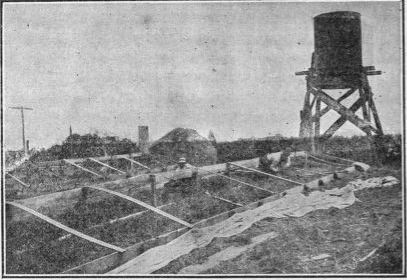Sweet Potato (Ipomoea Batatas). Part 2
Description
This section is from the book "Vegetable Gardening", by Ralph L. Watts. Also available from Amazon: Vegetable Gardening.
Sweet Potato (Ipomoea Batatas). Part 2
Florida
The vines of the Florida variety are large and vigorous. The potatoes are rather large, light salmon yellow, smooth and regular, of short spindle shape, with light yellow flesh. This variety is not so sweet as the Georgia and is inclined to be dry and mealy. It yields fairly well and is adapted for home use.
Pierson
The vines of the Pierson are similar to those of the Red Bermuda variety. The potatoes are light yellow, of short spindle shape, very rough, with creamcolored flesh. This sort is extensively grown for the earliest market, but it is of only fair quality. It yields well if allowed to remain until late in the season.
Black Spanish, Or "Nigger Choker"
The Black Spanish vines are very long, vigorous, and dark purple in color. The potatoes are long, cylindrical, crooked, or bent; dark purple in color, with snowy white flesh and poor quality. This variety is grown mostly for stock feeding.
Shanghai
The vines of the Shanghai variety are large and vigorous; the potatoes long, cylindrical; the outside color almost white. The flesh is creamy white, becoming darker in cooking. When baked the flesh is somewhat dry and mealy and the flavor rather poor. This variety yields fairly well and is adapted for use as stock food in the Gulf Coast States.
627. Climatic Requirements
There are extensive areas in the United States which are well adapted to sweet potatoes, mainly because of suitable climatic conditions. The plant is very tender and demands high temperatures. An abundance of sunshine is essential to high yields. Although a liberal rainfall is desirable during the growing season, it is detrimental when the tubers are maturing, because it encourages excessive vine growth at the sacrifice of tubers. There should be a growing season of not less than months without frost. Warm nights are important to obtain the best results. This vegetable is often grown in northern gardens, but it is futile to attempt its cultivation commercially where climatic conditions are unsuitable.
628. Soils
The lighter soils are invariably regarded as the best for sweet potatoes. A moderate proportion of sand in the top soil, with a fairly retentive subsoil, provides ideal conditions. Whatever the soil type, it must be warm, loose and well drained. Stiff, heavy soils should never be planted with this vegetable. When it is necessary to use such soils in supplying sweet potatoes for the home table, their structure should be modified by the addition of large amounts of vegetable matter. The vine growth is likely to be excessive on stiff soils and the tubers are rough and unsymmetrical. New land is regarded especially valuable for this crop. Calcareous soils, when properly handled, often produce good results. Some of the driest and most sandy soils give good yields of fine tubers when seasonal conditions are favorable. Sweet potatoes can often be made to pay on lands too poor for cotton or tobacco, although the highest yields cannot be expected in impoverished soils.
629. Seed
The tubers for the propagation of plants for next year's crop should be selected when the crop is dug. Some growers attend to this matter with the greatest care. Individual hills are studied and the tubers are chosen with reference to productiveness, size, shape and uniformity. With white potatoes, hill selection has been clearly demonstrated to be valuable, and there are reasons for its practice with sweet potatoes, but the experimental evidence in its favor is not very conclusive. The same may be said with reference to the use of tubers of various sizes. The experiment stations have not been able to show that it is profitable to use large tubers for seed, although there is some evidence in their favor. In many regions of prominence the small tubers are chosen because they keep better than large ones in storage, are worth the least on the market, and a bushel will produce a greater number of plants than larger tubers. When several "drawings" are made, from 1 1/2 to 2 bushels of small potatoes are required to grow enough plants for an acre; 2 to 4 of medium size and 4 to 10 of large size to plant the same area. (U. S. D. A. Farmers' Bul. 26, p. 9). The medium size, 2 inches in diameter or less, is preferred by many growers. A bushel will produce from 2,000 to 2,500 plants when two drawings are made. Varieties vary greatly in their power of reproduction, and this difference is often recognized in the charges made by plant dealers. In the far South, where the summers are very long, so that cuttings may be made with freedom after the plants begin to vine, an acre in the field may produce enough plants for 1 to 4 acres, although too severe pruning will reduce the yield on the propagating area. Plants from cuttings are said to produce the best seed. Whatever the size of tubers selected, they should be handled with extreme care to prevent bruising and injury and kept as directed in the notes on storage (637). Freedom from disease is especially important.

Fig. 101. frames for growing sweet potato plants.
Continue to:
Tags
plants, crops, gardening, cultivated, harvesting, food ,greenhouses, fertiliser, vegitables
